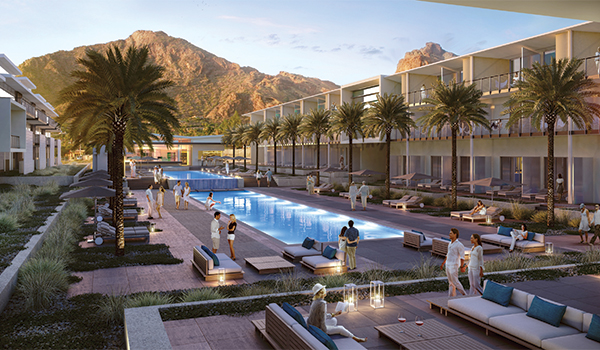
Mountain Shadows
In 2015, the latest year for which industry figures are available, the greater Phoenix area welcomed an estimated 22 million visitors, who were responsible for $13.6 billion in estimated direct spending, according Megan Doyle, senior manager of corporate communications and community relations with Visit Phoenix, crediting a report by Longwoods International Dean Runyan Associates. “Without a doubt,” she says, “the visitor industry drives economic development in our community.”
The report the Tempe Tourism Office released earlier this year by Tourism Economics cites $122 million generated for Tampe in tax revenues in 2015, including $36.2 million in local taxes.
The City of Mesa realized a return of $18.56 on every dollar it invested into its convention and visitors bureau, Visit Mesa, according to the bureau’s president and CEO Marc Garcia, who notes that’s a very conservative assessment that “does not include consumption by leisure travelers who likely booked Mesa hotels and other Mesa travel products as a result of Visit Mesa’s national digital, print and social media marketing campaigns.”
And, reporting that nearly 9 million visitors come to Scottsdale each year, Experience Scottsdale’s president and CEO Rachel Sacco says, “Our overnight domestic visitors, alone, spent $1.2 billion in the destination in 2015, according to the City of Scottsdale. That doesn’t include spending from our high-value international visitors, including those from Canada. Visitors to Scottsdale generate nearly $40 million in tax revenue, funding important resident services, as well as tourism promotion and development.”
What draws visitors here? Sure, we’ve got an enviable climate and one of the world’s seven wonders — and an industry has grown up that capitalizes on such attractions.
But professionals in that space are leveraging other elements of Valley life as well. Phoenix Convention Center Director John Chan, noting this concerted strategy by area hotels, the convention center and Visit Phoenix to “leverage what we have,” says of the biomedical education and research institutions in Downtown Phoenix, “There’s an opportunity to really target conventions and meetings for businesses in that field, such as pharmaceutical and medical companies.”
And Vittal Calamur, general manager of FOUND:RE Phoenix, a boutique arts and culture hotel that opened late last year in Downtown Phoenix’s arts district, shares, “USA Today names Roosevelt Row one of top 10 art communities in the country, so we capitalize on that.”
Tourism’s Economic Impact
The comprehensive research project, “The Economic Impact of Tourism in Tempe, Arizona,” recently released by the Tempe Tourism Office found that 3.7 million visitors to Tempe in 2015 spent $730.6 million in direct expenditures — and the combination of direct and indirect spending and induced impacts generated $1 billion in total business sales. Stephanie Nowack, Tempe Tourism president and CEO, notes the number of visitors increased 20 percent from 2011 to 2015, from 3.084 million in 2011 and 3.7 million, with 28-percent increase in spending, from $572 million in 2011 to $730.6 million.
According to the research, the tourism sector supported 8,467 jobs in Tempe, or one of every 13 jobs in the city. Tourism is a significant part of several industries, directly supporting nearly all employment in lodging, 40.5 percent of recreation, 19.4 percent of food and beverage, and 6.1 percent of retail. In addition, Tempe employees earned a total of $307 million as a result of visitor activity.
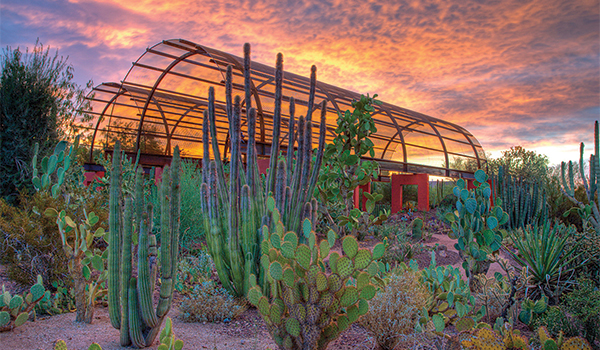
Desert Botanical Garden
In Scottsdale, one of every 10 jobs directly relates to tourism, according to Sacco, who characterizes it as one of the city’s largest industries. “It’s also one of our oldest industries, as people began traveling to Scottsdale for our healing climate in the late 1800s. That tradition has continued from the 19th century well into the 21st century. During that time, tourism helped spark our community’s economic growth and development.”
Visitors to Scottsdale generate $40 million in local sales- and bed-tax dollars. Half of all bed-tax revenue helps fund tourism-related events and capital projects, among which are improvements to TPC Scottsdale, the construction of Western Spirit: Scottsdale’s Museum of the West, and funding to expand Barrett-Jackson Collector Car Auction, but Sacco notes such revenue also supports essential public services like police, firefighters, public schools, transportation and more.
The $600 million expansion of the Phoenix Convention Center, begun in 2004 and completed in 2008 through a partnership between the City of Phoenix and the State of Arizona, tripled the facility’s size and “allowed us to compete for a bigger share of the convention and trade show market,” Chan says. Since then, he reports, the center has welcomed 1.7 million convention delegates, and generated approximately $228 million per year in direct spending impact to the state.
Of course, there’s a symbiotic relationship with the private sector. Dan Boyer, director of sales and marketing for the Sheraton Grand Hotel, located mere steps from the Phoenix Convention Center, points out the 1,000-room hotel “allows for the CVB and city in general to attract larger conventions.”
“Visitors touch so much more than just hotels; they are spending money at attractions, restaurants, shops, transportation. All of that spending supports local jobs — and local families,” Doyle says.
And, providing another perspective, Garcia notes, “The yield on visitor dollars and subsequent tax receipts is far more efficient than resident tax dollars, and visitors don’t typically require public services like jails, libraries and schools.”
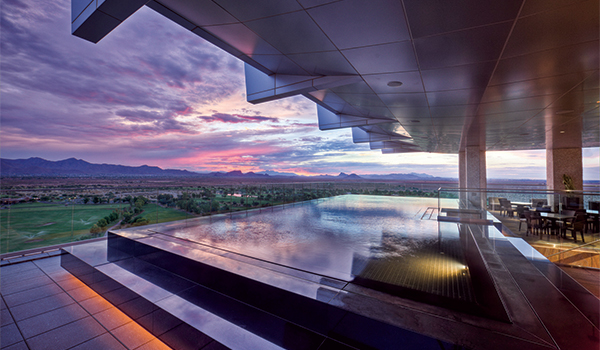
Orange Sky, a fine-dining restaurant located on the top floor of the Salt River Community’s Talking Stick Resort, offers spectacular views of Talking Stick Golf Club and the tribes’ 19,000 acres of natural preserve
Entertainment is a big part of the tourist draw, and entertainment is a purposeful focus of development — along with office and retail — by the Salt River Pima-Maricopa Indian Community for its commercial corridor along the Loop 101. In fact, the northern part of that corridor has been slated as the Talking Stick Entertainment Destination area as much of the development in that area is focused on entertainment, according to Blessing Mc Anlis-Vasquez, marketing manager of the Talking Stick Cultural & Entertainment Destination for SRPMIC. “When Salt River Fields at Talking Stick opened its gates to the public in 2011, it sparked a fire within the Community continues to burn bright today,” she says. “In early 2017, we welcomed iFLY indoor skydiving to the area, and look forward to seeing a Dunkin Donuts/Baskin Robbins storefront open its doors and the addition of offerings at some of our existing amenities, like virtual reality gaming at Octane Raceway.
“Development within the Community not only results in increased tax revenue,” she notes, “but additional jobs, increased awareness of our tribe and recognition of development in Indian Country as a whole.”
Doyle also emphasizes that promoting travel to the greater Phoenix area does so much more than generate visitor spending, and she cites Downtown Phoenix as the perfect case study of how the travel industry spurs economic development. “Fifty years ago, the downtown area would be unrecognizable to today’s traveler. But with the development of the Phoenix Convention Center and the surrounding hotels, the ability to bring large-scale groups and conventions became a reality. Slowly, the downtown area began to grow with new restaurants, theaters, shops and businesses. Today, we’re thrilled to see that Downtown continues to improve not only for the visitor experience, but also for the locals who live, work and play here.”
Impact on Other Business Sectors
“While our industry is sometimes characterized as being merely ‘fun’ or that our industry’s jobs are low-paying, this is a short-sighted view of this rather large and varied industry,” Garcia says. He points out that local grocery stores, gas stations, auto dealerships, farms and ranches are all very much tied to visitor spending. When friends and family come into town, we go buy extra food at the grocery store. This happens a thousand times a day all over the state. And, with more than 65,000 hotel rooms in Maricopa County — generating as much power as they do throughout the year — utility companies are also in the visitor industry. “No one knows the growth of food tourism more than Mesa’s regional attractions and partners such as the Queen Creek Olive Mill and Superstition Farms that make up Visit Mesa’s Fresh Foodie Trail®. Our farmers are now directly tied to visitors and their dollars as more visitors explore this region seeking out these culinary-related activities.”
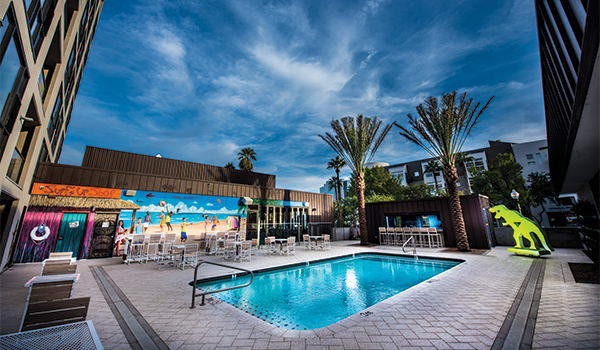
Found:RE Phoenix
Calamur points out that FOUND:RE Phoenix not only created 140 jobs in its hotel and restaurant, but created jobs for many local businesses as it was being built. “About 80 percent of what was done for the hotel was by local designers and fabricators.” And on an ongoing basis, the hotel’s three-meal restaurant has partnered with close to 80 local purveyors while its art program for guest rooms and public spaces works with a large number of local artists.
“Tourism is often the front door to economic development,” says Sacco. She reports that consumers exposed to Experience Scottsdale’s advertising were 106 percent more likely to view Scottsdale as a “good place to start a business”; those who visited Scottsdale, 116 percent more likely; and those who were exposed to the advertising and visited Scottsdale, 226 percent more likely. Tourism attracts corporations to hold conferences and meetings in the hotels, entices families to visit on vacation, and draws individuals to attend special events. “These opportunities allow CEOs and business owners to experience all Scottsdale offers — amenities they’ll consider when thinking about where to relocate or expand.” Case in point: In the early 1950s, Illinois residents Paul Galvin and his wife, Virginia, were Scottsdale-area winter visitors. After Galvin opened a division of his business just west of Scottsdale, he and his wife often stayed at the JW Marriott Camelback Inn during their trips. In 1957, Galvin moved more of his business — Motorola — to Scottsdale. “Motorola not only diversified Scottsdale’s economy and introduced high technology to the area,” Sacco says, “but company employees and their families created demand for housing, schools, retail and civic infrastructure.”
Experience Scottsdale, along with Tempe Tourism and the Arizona Office of Tourism, is among the many other local tourism organizations that SRPMIC works with, and McAnlis-Vasquez says the Community “absolutely benefits from the visitors their efforts bring to our beautiful state. … Each tourism organization offers us support as a Community and also supports and works directly with many of the enterprises themselves, so we are involved with them on multiple levels and enjoy working with such a talented group of tourism leaders to further promote tourism in Arizona.”
Quality of Life
Investments in visitor-serving products and services are smart for visitors who come for brief stints, and these investments make them want to come back again and again. “But it is just as important to remember that these products (hotels, golf courses, restaurants, convention centers, sports campuses, etc.) are enjoyed by residents 365 days a year and contribute to the admired quality of life we boast,” Garcia says.
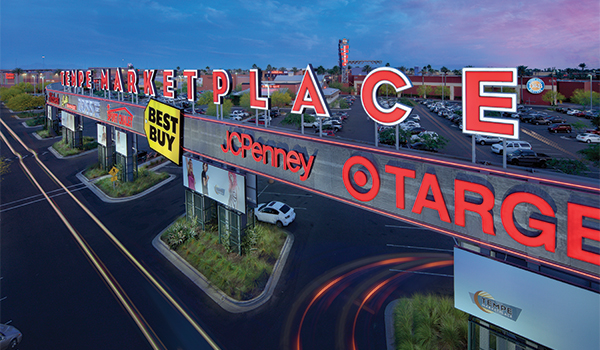
Tempe Marketplace
And it can work the other way around, too, with amenities developed for the residents contributing to the tourism efforts. Ralph Remington, artistic director of Tempe Center for the Arts and deputy director for arts and culture at the City of Tempe, says that while the Tempe Center for the Arts is not competing in the tourism space — “the Greater Phoenix Metro area is our target market” — the TCA is an important part of the attraction of Tempe as a whole and of the economic value of Tempe Town Lake, on whose shore it sits. “The economic value of Tempe Town Lake is about $2 billion, which includes development, special events, boating and tourism.” He adds, “In the last six months, approximately 10 percent of the traffic to our website has come from out-of-state tourism — some as far as Mumbai and Calgary.
Industry Challenges
There may be an impact on tourism in general as a backlash from travel bans by the federal government, Nowack shares. She notes that Tempe Tourism has been actively pursuing business in Mexico and Canada, and it has been successful, “but we don’t know if that will change” with the uncertainty of the political climate.
Another challenge she cites is in funding. “Funding for the Arizona Office of Tourism is lower than other states.” That hinders efforts to market Arizona for tourism. Yet, Nowack notes, “Competition from other destinations is always increasing.” So there is great need to differentiate what’s here from other destinations — the Grand Canyon, of course, but also the wide diversity from desert to mountains and even between cities.
“As a destination, we need to continue adding and improving attractions and amenities in order to attract new tourists while maintaining our appeal to long-time visitors,” Sacco says, noting Scottsdale faces fierce competition from other destinations.
But further, “As a destination marketing organization, Experience Scottsdale must continually improve as well,” Sacco says. “That’s why we unveiled a new destination brand last year. During 18 months of research and development, we closely examined consumer perceptions of Scottsdale and built a brand that appeals to our current and potential visitors. We are competing with destinations that have budgets two to three times larger, but we strive to get our message to our top visitor markets like New York, Chicago, San Francisco, Denver and Canada through high-impact advertising campaigns.”
Visit Mesa rebranded and re-engineered its sales organization in FY 2013, and Garcia reports its booked room nights are up nearly 700 percent since then.
And in terms of meeting consumer needs, “Consumer experience is even more important now, with consumer feedback sites, especially in this high-density resort and restaurant town,” says Jesse Thompson, director of sales and marketing at Mountain Shadows in Paradise Valley, speaking from 40 years’ experience in the industry here. “Anticipating needs is big, and individualizing service to personal taste.” Although he says of Mountain Shadows’ recent opening, “It’s been almost 10 years since the last one in our size and scope opened,” he cites added room supply as one of the challenges.
Similarly, Boyer notes the hotel market in Downtown Phoenix has gotten more competitive since the Sheraton Grand opened eight years ago, but on the flip side, “It bodes well for attracting larger conventions.”
But another challenge for his location is “there’s a perception that Downtown Phoenix is like a ghost town; ‘What’s there to do in Downtown Phoenix?’” So, it’s important the hotel community and the CVB get the message out to both meeting planners and the leisure traveler that “Downtown Phoenix is more vibrant than even five years ago.”
“Even locals don’t know about what’s happening downtown,” Calamur says, although he believes Phoenix is starting to be recognized as more than a sleepy town. He keeps FOUND:RE Phoenix involved in community events to help raise its profile locally, and adds to the arts scene with an eight-story digital-projection exterior light installation as well as an outdoor display box that provides omnipresent public art by exhibiting ever-changing, avant-garde masterpieces created by local artists. The business model incorporates the surrounding residential area. “It’s important that people have a place where they can walk around, and have things to do and see,” he says. And the hotel needs the additional business beyond its room guests to help fill amenities such as its restaurant.
Fresh and Refresh
“The trend now is ‘art hotel,’” Calamur says. FOUND:RE Phoenix is taking that seriously, and brought in Michael Oleskow as cultural curator. Oleskow was board president of Artlink Phoenix for two years and has long been involved in the Phoenix art scene, and brings his wealth of contacts to the hotel’s unusually immersive art program.
Oleskow has sourced more than 25 artists to feature works of various mediums enmeshed into every aspect of the guest experience, igniting curiosity and a sense of discovery. Both the Studio and the Gallery spaces feature a roster of rotating shows, pop-ups and artists throughout the year, with good quality prints of the originals in each of the hotel’s 105 guest rooms. Oleskow calls it “sleeping with the artist,” and explains, “What differentiates us as a boutique hotel is, all art is local and all art is for sale.”
Adds Vittal, “We’re marketing to a different crowd, who aren’t looking for a golf resort or pools, to lay out in the sun. They’re more energetic, and looking for an adventure rather than what’s traditional in Arizona.”

The planned Ritz-Carlton, Paradise Valley
Addressing that subject from the standpoint of the Scottsdale CVB, Sacco says, “As both a destination and organization, we must keep an eye on the changing habits and tastes of travelers.” Recognizing the trend of travelers looking for localized, experiential vacations, she points out the hotels and resorts are making investments and renovations that better speak to those changing desires, from creating inviting lobbies that act as gathering spaces to adding restaurants with locally sourced menus. “One of the Scottsdale area’s newest properties, Andaz Scottsdale Resort & Spa, partnered with the local Cattle Track Arts Compound to create art for the lobby, restaurant and guest rooms. Cattle Track artists also participate in a weekly artist-in-residence program at the resort.”
The Sheraton Grand is also reaching out to a new market. Seventy percent of its business is group conventions, but Boyer says that, over the past three years, it has been making a more concerted effort to attract the wedding market, and it has begun to focus on the leisure market perspective with packages around the Diamondbacks, the Herberger Theater, and other local attractions.
McAnlis-Vasquez relates that SRPMIC is focusing the majority of its promotional efforts on the Talking Stick Destination area, which includes Talking Stick Resort, Talking Stick Golf Club, Salt River Fields at Talking Stick, the Pavilions at Talking Stick, Topgolf, Octane Raceway, iFLY, Butterfly Wonderland, OdySea Aquarium, Dolphinaris Arizona, the Hampton Inn and the Courtyard Marriott Scottsdale Salt River. Noting that many of these facilities are new to the market and bring a uniqueness to Arizona’s entertainment offerings, she says, “Add the fact that these entities are located within a tribal community and it further enhances the draw, as guests will get to see and feel our cultural influences all around them.
“We are also very proud of the story that we have to tell as a community, and make a concerted effort to promote the cultural experiences that can be found within the area for those seeking that type of experience. We are unique in that most of our developments are architecturally or experientially influenced by the two tribes that call Salt River home, so, even though the amenity itself may be modern, there is influence in the space that tells a story.” For example, iFLY is the newest area amenity and offers indoor skydiving, but the building features a birds-in-flight image that, historically, was used in basket designs and on pottery, and also features a large sitting area outside its main entrance with a design influenced by Pima basketry. “As a Community, we try to enhance the marketing efforts and messaging that our partners already doing. If, as a group, we are able to define an area or program that would be beneficial for most everyone but there is currently no presence in that space, we will focus our efforts there.”
Events are a critical component of Scottsdale’s product inventory, whether as a motivator for travel or an enhancement to the visitor experience, according to Sacco. “Events help drive new and repeat visitation and establish the city as a destination that caters to residents and visitors with a wide-range of interests. Fortunately, Scottsdale is home to world-class special events like the Barrett-Jackson Collector Car Auction, the Waste Management Phoenix Open, the Scottsdale Arabian Horse Show and more.”
And opportunity is magnified throughout the Valley. In fact, Nowack says of Tempe, “We’re a big events city.” Tempe has hosted the Rock ’n’ Roll Marathon since 2004, which Nowack says consistently brings more than 25,000 people. “And we get half of those room nights, because the finish line is here.” Ironman, hosted by Tempe since 2005, draws participants from every U.S. state plus 32 countries. Twenty-eight hundred participated in the recent Pat’s Run. Plus, of course, Tempe is home to ASU.
And Phoenix promotes its convention center. “We’ve been trying to position the Phoenix Convention Center as a boutique brand, providing wonderful and distinctive facilities, efficient buildings and customer service,” Chan says, noting, “If attendees have a good experience, meeting planners will want to come back.” It’s also venturing into special events, according to Chan, who says the center now houses offices for a new position the city created to coordinate major events. Coming up this October, for instance, is the Lost Lake Music Festival at Steele Indian School Park. “It speaks to how Phoenix has grown as a market,” Chan says, explaining producers are looking for communities where locals as well as out-of-town people will support events.
Part of the reason mega events are often used by economic development agencies to promote business to and within the state of Arizona is what the national exposure can, potentially, attract, Garcia explains. “Much of tourism’s impact goes back to quality of life. If C-level executives come to Arizona and love the restaurants, the climate, the housing, cost of living, golf courses, hotels, spas and more, there’s a strong chance they could see themselves living here and strongly consider moving their base of operations here.”
















Speak Your Mind
You must be logged in to post a comment.